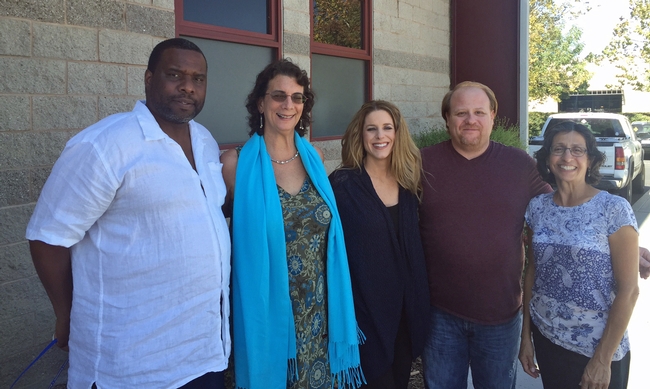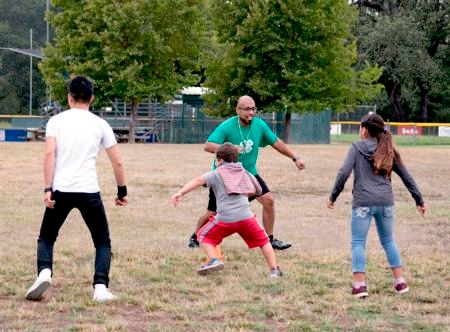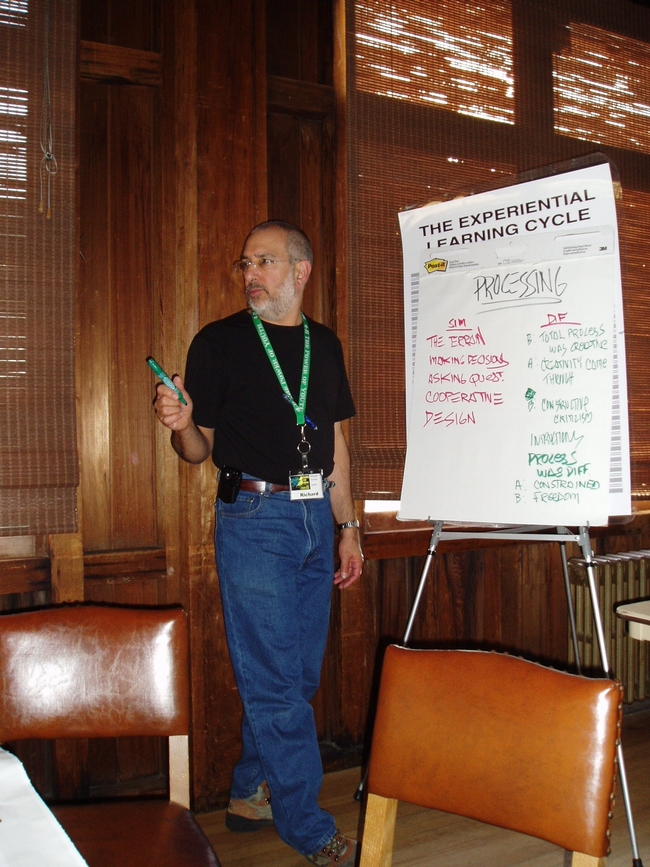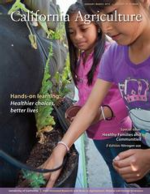Posts Tagged: youth development
4-H Youth Development team wins national diversity award
UC 4-H Youth Development advisors Dorina Espinoza, Russell Hill, Fe Moncloa and Keith Nathaniel and 4-H associate director Shannon Horrillo have won the National Extension Diversity Award for systematically enhancing the intercultural competency of 4-H personnel and others in California. The National Extension Diversity Award was presented Sunday, Nov. 13, at the 129th Association of Public and Land-grant Universities Annual Meeting in Austin, Texas.
The award, given by USDA National Institute of Food and Agriculture (NIFA), Cooperative Extension System and the APLU, honors the team for developing and institutionalizing a professional development strategy to increase staff and academics' intercultural competence.
To support the development and well-being of California's culturally and ethnically diverse youth population, research indicates that building intercultural competence among youth development professionals is critical.
“We have been making changes to our programs to remove barriers and make 4-H more accessible. We are also testing new delivery models to expand 4-H's reach, particularly among Latino youth and families,” Horrillo said.
“This effort has been extremely successful and we are seeing the benefits in our membership,” said Horrillo. “The program's growth over the last year was significant, with a 16 percent increase in youth participation and a nearly 42 percent increase in Latino youth participation.”
“We asked Latino parents how we can help,” said Lupita Fabregas, assistant director for 4-H Diversity and Expansion. “Working parents suggested after school programs so they don't have to drive their kids to a different location.”
Through a pilot initiative in seven counties – Riverside, Orange, Kern, Santa Barbara, Monterey, Merced and Sonoma counties – UC ANR's 4-H Youth Development Program now offers in-school, after school and special interest clubs that explore subjects such as robotics. Children can join clubs that focus on projects for four to six weeks, rather than 4-H's year-long commitment. Bilingual and bicultural program representatives provide materials in English for the children and Spanish for parents. Although the activities are structured differently, they aim to teach Latino children science, leadership, civic engagement and other life skills taught through the traditional program.
The team of change agents applied the professional development strategy over three years, providing 176 hours of intercultural communication feedback sessions, learning communities and regional conferences to enhance the intercultural competence of 65 California 4-H personnel.
The UC ANR 4-H Youth Development Program has also assembled an advisory committee for 4-H multicultural and community engagement that includes Latino leaders Mary Lou de Leon Siantz, a professor at the Betty Irene Moore School of Nursing at UC Davis and director of the Center for Advancing Multicultural Perspectives on Science (CAMPOS); Steven Olmos, chief schools officer for Santa Clara County Office of Education; Albert Maldonado Jr., youth program manager for The California Endowment; and Juan P. Garcia, deputy director of the California Hispanic Chambers of Commerce.
UC ANR's action plan and resulting positive change provides a model for 4-H in other states to improve professional development and expand the program's reach. A summary of California's IDI professional development activities can be found in the National 4-H Latino Youth Outreach: Best Practices Toolkit, Professional Development.
Richard Enfield wraps up “dream career” as 4-H advisor
“It was my dream career and I knew that it was the ideal career for me from the early stages of my job as a 4-H youth development advisor in San Luis Obispo County,” said Richard Enfield, who retired in July after a 33-year career as UC Cooperative Extension advisor and county director.
While growing up in urban Irvington, New Jersey, neighbor to Newark, Enfield hadn’t considered a career in agriculture. Community gardening and community supported agriculture experience piqued his interest after he moved to Santa Barbara so Enfield enrolled in the UC Santa Cruz Farm and Garden Project, which was a 12-month apprenticeship program. While studying at UC Santa Cruz, he was introduced to UC Cooperative Extension. He stayed on another year working as a field assistant to the director Stephen Kaffka, who is now a UC Cooperative Extension specialist in the Department of Plant Sciences at UC Davis.
“I became very interested in teaching methods and experiential education and learning,” Enfield said.
Enfield began studying agricultural sciences at Cal Poly San Luis Obispo and joined UC Cooperative Extension as a summer intern in the UCCE 4-H office in San Luis Obispo County after earning his B.S. degree in June 1980. Three months later, he was hired as a 4-H youth development advisor. Under his leadership, the 4-H youth development activities evolved to incorporate more research-based approaches to foster a commitment to learning, positive identity, social competency and positive values.
“Over the years, Richard made the 4-H program more visible in San Luis Obispo County by reaching out and offering the program to not just the traditional club audiences but to other youth,” said JoAnn Overbey, who has volunteered with 4-H for 42 years.
“I remember years ago when 4-H was set up in housing projects in the North County,” Overbey said. “He started the 4-H SLO Scientists Program that youth could join, and this program was years ahead of the UC SET (Science, Engineering and Technology) Program that started a few years ago.”
Enfield designed 4-H SLO Scientists in 1996 to engage families in the hands-on science activities because research shows that direct parental involvement is an important influence on student achievement. More than 1,500 people have participated in the program. In 2011, the program was recognized as one of 4-H’s 15 promising science programs in urban communities across the country.
“SLO Scientists today is still one of our most popular groups to join,” said Overbey, who works for San Luis Obispo County Department of Social Services as a program review specialist for foster care and adoptions. “It can be started in the smaller communities and we reach youth who would not otherwise know about or join a traditional 4-H Club.”
In 1987, Enfield earned an M.A. in educational psychology and research methods from UC Riverside. In 1991 he was appointed UCCE director for San Luis Obispo County, serving for two years. In 2005, he was reappointed UCCE director for San Luis Obispo County and added oversight in Santa Barbara County in 2008, leading UCCE in both counties until his retirement. He also served as interim UCCE director for Ventura County from April 1, 2011, until Aug. 31, 2012.
“Richard was always there with high expectations for performance coupled with personal support and caring,” said Mary Bianchi, a UC Cooperative Extension advisor who reported to Enfield and succeeded him as UCCE director for San Luis Obispo and Santa Barbara counties.
In 2010, Enfield began serving as a 4-H advisor for Santa Barbara County in addition to San Luis Obispo County.
Locally he created a middle-management structure to strengthen the 4-H program. The middle-management structure empowers adult volunteers and teen leaders and allows them to serve in critical 4-H management and program development roles at their peak levels of performance. UCCE offices in other counties have recently begun adopting his model. He also presented the middle management approach at state and national conferences.
“Through his local impacts and national efforts, Richard can rest assured that he has been important in the lives of thousands of children and generations within families,” Bianchi said.
“I can tell you with complete honesty that we would not have the huge steady increase in enrollment without his leadership and skills guiding us,” Overbey said. “He went after all types of available grants that allowed our program to extend beyond just the club level – grants that allowed our youth to be involved in things like oak tree plantings and a 4-H hiking program.”
Enfield has won numerous accolades over his career. In 2005, the San Luis Obispo County Board of Supervisors issued a proclamation recognizing his 25 years of service to children, youth and families in the county. In 2010, his professional peers honored him with the Meritorious Award from the National Association of Extension 4-H Agents. For his work behind the scenes at the statewide administrative level, colleagues acknowledged Enfield with the UC Agriculture and Natural Resources Distinguished Service Award for Leadership in 2011. In February, the Board of Directors of the California Mid-State Fair presented Enfield with a Resolution in Appreciation of Service for “outstanding contributions to the California Mid-State Fair.”
“I loved the freedom to be creative and I enjoyed getting to know all the wonderful and diverse people whom I got to work with and collaborate with on issues of positive youth development and community development,” Enfield said. “Every day was different, exciting and I always felt I was contributing to my community.”
Enfield has been active in the community as well, serving as a member of the Child Abuse Prevention Council of San Luis Obispo County, the Bakari Project Advisory Board at Cal Poly and the SLO Children’s Services Network and participating in the San Luis Obispo County Community Foundation “Pathways to Adulthood” Initiative.
Enfield and his wife Elaine Cormier, a retired optometrist, plan to stay in San Luis Obispo and spend more time hiking, ocean kayaking and bicycling to explore the natural beauty of the area.
“I plan to remain active in the community through various organizations, such as the Asset Development Network of San Luis Obispo County,” Enfield said. “The Asset Development Network is a collaboration of agencies, organizations, and individuals who have come together in order to promote positive youth development throughout the county.
He will also pursue his personal passions of attending ballet performances and baseball games and collecting publications about the West.
“I will continue adding to and developing my collection of over 1,300 modern first editions, dozens of broadsides, and ephemera exploring the American West,” said the East Coast native, explaining that broadsides are beautiful single page prints of book excerpts or poems. “My extensive collection explores the old West to the new West and what it means to be Western and live and work in the West. The collection of fiction, associated nonfiction, and poetry both perpetuates and dispels the myths of the West and explores the sense of place that is so prominent in the literature of the West.”
UC has granted Enfield the prestigious emeritus status so he will continue working on his state and national research projects on the development of individual and community social capital through the 4-H program.
UC initiative to help youth improve health, education and science literacy
Original research and literature reviews on these subjects appear in the January-March 2013 California Agriculture, UC’s peer-reviewed research journal of research in agriculture, natural and human resources (http://www.californiaagriculture.ucanr.edu).
UC Agriculture and Natural Resources (ANR) has launched a strategic initiative to help California youth. Called Healthy Families and Communities, it includes research and programs to encourage healthy lifestyles, boost science literacy, and foster positive youth development. Delaine Eastin, former State Superintendent of Public Instruction, notes, “At the end of the day, the Healthy Families and Communities Strategic Initiative is about change, scientifically measurable change, yielding concrete evidence of youth improvement due to these efforts.”
The facts underlying the initiative are startling. Nearly half of the state’s adults could be obese by 2030, according to a 2012 report by the nonprofit Trust for America’s Health. Obesity is linked to chronic illnesses, such as type 2 diabetes, heart disease and high blood pressure.
In addition, each year about 100,000 California youth who reach graduation age fail to graduate from high school, a predictor of their future social and financial difficulties as well as a missed opportunity for training skilled workers to replace those close to retirement. Finally, California’s eighth-grade science scores ranked 47th among the states in the National Assessment of Educational Progress’s 2011 report. A workforce with the knowledge and skills for scientific careers is critical to the state’s economy, and to full participation in today’s technological society.
Confronting these complex issues requires a multifaceted approach that leads to strategic change, says David Campbell, UC Cooperative Extension specialist in the Department of Human and Community Development at UC Davis and leader of ANR’s new youth-focused initiative.
“We’re bringing a lot of people together across disciplines,” he says. “If our work is going to be relevant to the real world, we need to reflect its complexity.”
As part of the initiative, UC researchers are partnering with schools and youth organizations in controlled studies to learn what works in the real world.
Summaries of projects and links to articles:
Integrating local agriculture into nutrition programs can benefit children's health (page 30). Sheri Zidenberg-Cherr, UCCE specialist in the Department of Nutrition at UC Davis, leads a K-6 nutrition education effort, called Shaping Healthy Choices. Designed to both improve child health and support local agriculture, the program incorporates serving regional fruits and vegetables, a school garden, and classroom nutrition and physical fitness lessons. In this controlled four-year study, investigators have matched schools in Northern and Central California, and will compare those that are implementing the program with those that are not.
Communitywide strategies key to preventing childhood obesity (page 13). According to Pat Crawford, UCCE specialist in the Department of Nutritional Science and Toxicology at UC Berkeley, increasing consumption of fruits and vegetables is important but not enough by itself to combat obesity. Two of the strongest factors driving obesity are sweetened beverages and fast food, and decreasing their consumption is just as important as increasing the consumption of healthy foods. “You have to do both,” she says.
Her team at the Center for Weight and Health in Berkeley, with funding from ANR, is evaluating Team Up for Good Health, a community-based approach to preventing obesity in elementary school children. Investigators are studying fourth- and fifth-grade participants in school and after-school obesity prevention programs, using body mass index (BMI) reductions after two years as a measure of success.
Lessons of Fresh Start can guide schools seeking to boost student fruit consumption (page 21). In 2005, California became the first state to address the availability of fresh and local produce in the federal School Breakfast Program through state funding. This evaluation of the California Fresh Start program reveals lessons that are especially important now, as schools across the country prepare to increase the number of fruits and vegetables offered in the School Breakfast Program by July 2014 as part of the Healthy, Hunger-Free Kids Act.
Inquiry-based learning (pages 47 and 54). Another innovative aspect of these UC programs is the curriculum. Based upon inquiry-based learning, it captures the attention of students by focusing on the real world and children’s day-to-day lives. For example, in the Shaping Healthy Choices program (page 30), a lesson on food labels at school will be followed by students comparing food labels on their own, at home and in grocery stores. “Application is what makes learning stick,” says Martin Smith, UCCE specialist in the School of Veterinary Medicine who works on youth science literacy. “Inquiry-based learning takes longer, but it’s deeper — kids own the knowledge because they figured it out themselves.”
Positive youth development merits state investment (page 38). A team of UC researchers reviews studies supporting a new paradigm for youth programs, and proposes increased state investment in this area. Research over the last 30 years has shifted thinking away from the deficit model, in which researchers and practitioners considered high-risk youth behaviors to be their focus, and toward promotion of positive patterns. “Far too many California youth are not thriving,” the authors note. “Promotion of healthy pathways to college, work and community engagement is of urgent concern.” They cite findings that positive youth development is linked to improved school achievement, higher graduation rates, and fewer risk behaviors.
The entire January-March 2013 issue can be downloaded at http://californiaagriculture.ucanr.edu.
California Agriculture is the University of California’s peer-reviewed journal of research in agricultural, human and natural resources. For a free subscription, go to: http://californiaagriculture.ucanr.edu, or write to calag@ucanr.edu.
WRITERS/EDITORS: To request a hard copy of the journal, e-mail crllopez@ucanr.edu.
UCCE director-advisor Johns retires after 38 years of serving Californians
A summer job during college set Marilyn Johns on a path leading to her successful 38-year career of designing youth development and nutrition education programs to fit the student with UC Cooperative Extension. On July 1, Johns will retire as UCCE director for Santa Clara, San Francisco and San Mateo counties and Elkus Ranch and UCCE advisor for 4-H and nutrition, family and consumer sciences.
While earning a bachelor’s degree in home economics education from South Dakota State University, Johns took a summer job with South Dakota Cooperative Extension teaching at an Indian reservation.
“One of my assignments was to teach nutrition to families on the reservation,” Johns recalls. “That’s where I learned that delivering a scripted program is not always the most effective. The beauty of Cooperative Extension is having the flexibility to tailor educational programs to meet the needs of your clientele.”
Although the Brookings, S.D., native had participated in 4-H and her father was a Cooperative Extension economics specialist at South Dakota State University, Johns didn’t really know the community-based educational organization until she began working for UC Cooperative Extension in 1974 as an advisor for Plumas, Sierra, Lassen and Modoc counties. She coordinated the 4-H youth development and nutrition education programs for those four counties until 1983, when she became a UCCE advisor in El Dorado and Amador counties in the same role.
In 1985, Johns transferred to San Mateo and San Francisco counties to serve an urban population as the UCCE 4-H youth development and nutrition, family and consumer sciences advisor. One of her projects was starting a school garden in Pacifica. She recruited senior citizens to teach the children how to grow vegetables. The senior citizens’ requests for guidance led her to develop TWIGS, 30 gardening and nutrition lessons for “Teams With Intergenerational Support.” Published in 1997, Johns continues to receive requests for the TWIGS curriculum. More than 3,500 copies have been sold to schools, after school programs, parks and recreation and YMCA programs, senior centers, nutrition networks and food banks in 22 states. California’s Department of Education uses TWIGS as an example of gardening curricula addressing education standards.
While serving the Bay Area, Johns earned a master’s degree in public administration with an emphasis in human resources at Notre Dame de Namur University in Belmont. In 2005, Johns was promoted to director for UCCE in San Francisco and San Mateo counties and director of Elkus Ranch, an environmental education and conference center in Half Moon Bay that provides hands-on learning experiences for San Francisco Bay Area youth. In 2011, Johns was also named director of UCCE in Santa Clara County.
In addition to promoting nutrition education and agricultural literacy through gardening, Johns has studied teen pregnancy. An article that she coauthored, “Best Practices in Teen Pregnancy Prevention,” was one of the most visited online articles of the Journal of Extension in 2005.
A founding member of the San Mateo Food Alliance System and a member of the statewide School Garden Network, Johns and nonprofit partners Hidden Villa and Collective Roots recently received a three-year grant of $173,000 per year from Sequoia Healthcare District to improve children’s health through garden-based learning.
While there have been groups who advocate for school gardens and those who promote nutrition, they haven’t always worked together in the past, says Jennifer Gabet, nutrition manager for Sequoia Healthcare District. Through a unique collaboration and development of a model teaching garden, 1, 2, 3 Let’s Grow! will emphasize growing edible plants, providing the students with fresh produce to eat and demonstrating how to prepare the fruit and vegetables they grow.
“Marilyn has been able to bring the two groups together, to see the garden as a mechanism to improve the school food environment and nutrition education,” Gabet said. “They teach science, but it doesn’t always include nutrition – discussion of the benefits of the foods grown and how students and families can include them in their diets to support their health.”
“This grant is pretty exciting,” Johns said, explaining that it incorporates nutrition education into hands-on activities for children, which is a more effective teaching method. She oversees the UC Master Gardener volunteers and UCCE nutrition educators who will be training K-12 teachers, parents and other participants at up to 34 schools on how to enhance children’s learning while gardening.
In retirement, Johns, who has been granted emeritus status, looks forward to continuing to contribute to garden-based learning as well as spending time with family and traveling for pleasure.







